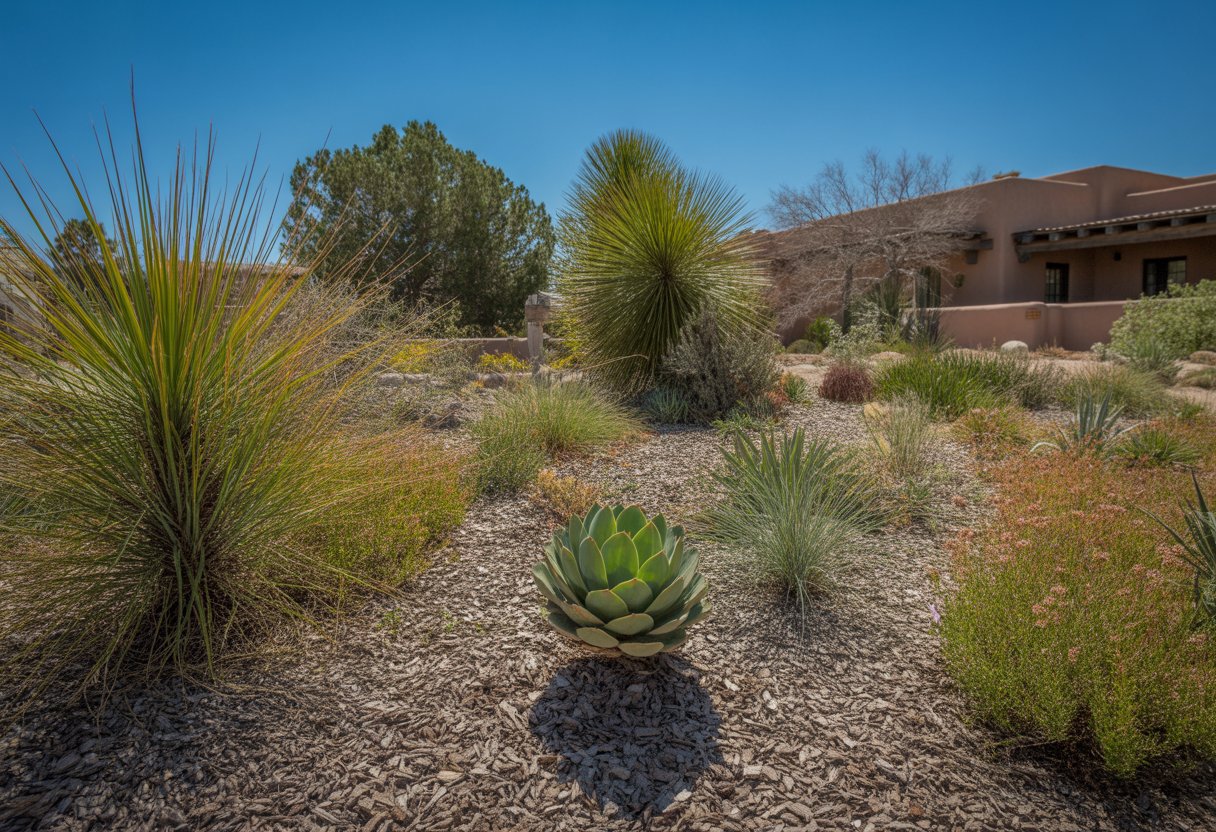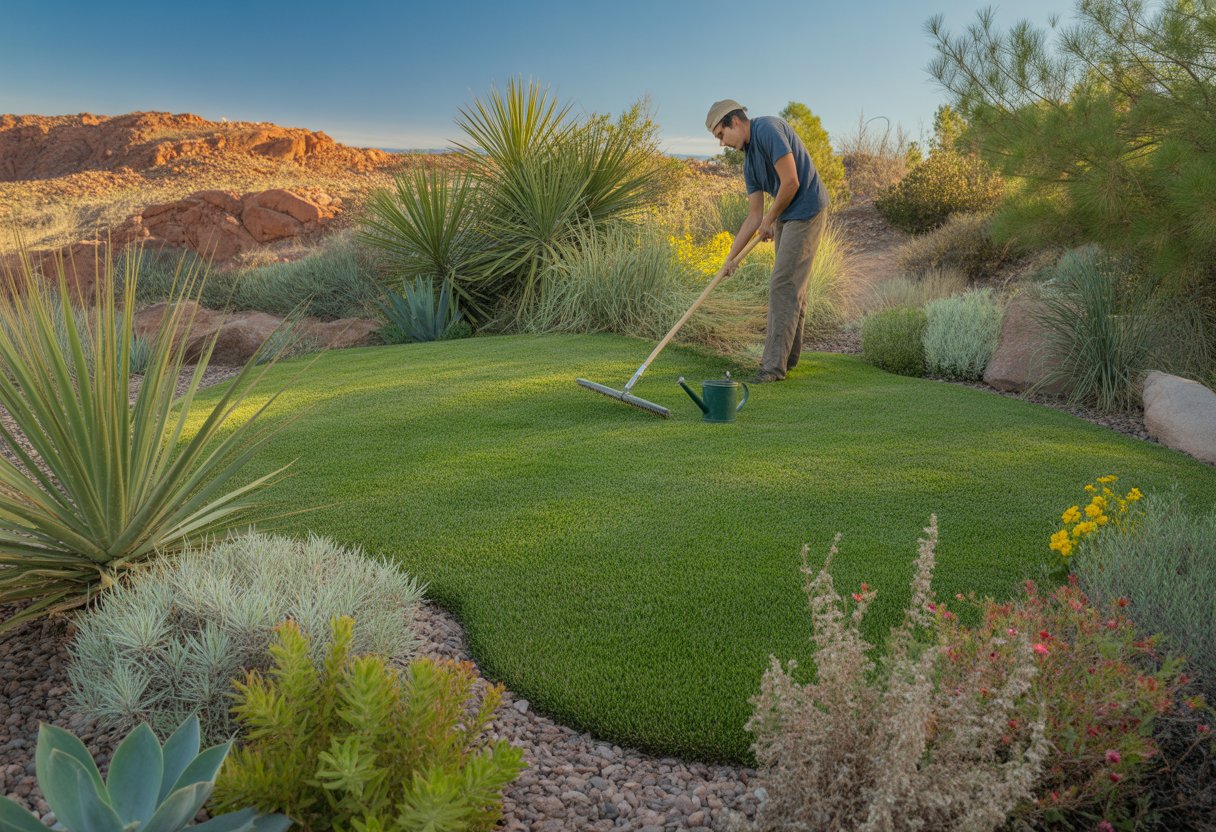Eco-Friendly Lawn Alternatives New Mexico for Sustainable Landscaping Solutions
New Mexico’s climate is a whole different ballgame—dry, unpredictable, and tough on traditional lawns. Trying to keep grass green here? It’s expensive and exhausting, honestly.
So, more folks are ditching the old-school lawn for eco-friendly options. These alternatives use less water, need less fuss, and actually help local wildlife do their thing.

Native grasses, drought-tolerant ground covers, and xeriscaping plants are super practical for outdoor spaces in New Mexico. They don’t guzzle water and actually thrive in the region’s soil and wild weather.
If you make the switch, you’ll use fewer resources and end up with a yard that’s way more resilient. Plus, it just fits better with New Mexico’s whole vibe.
Why Choose Eco-Friendly Lawn Alternatives in New Mexico
Eco-friendly lawn alternatives just make sense here. They cut down on water bills and keep your weekends free from endless yard chores.
You’ll also avoid dumping chemicals on your property, which is good news for your family, your pets, and the neighborhood birds.
Climate and Water Challenges
Droughts are a fact of life in New Mexico, and water conservation is more than a suggestion—it’s survival. Classic lawns? They’re thirsty, and they’ll drain your wallet if you let them.
Switching to native grasses, xeriscaping, or drought-tolerant ground covers means your soil holds onto moisture better. These plants evolved to get by with less, so you can water less and still have a healthy yard.
When you adapt your landscape to the climate, you help your soil stay healthy and avoid the mess that comes with overwatering. No one wants a muddy, eroded yard anyway.
Environmental and Cost Benefits
Eco-friendly lawns are cheaper to keep up. Less watering, less mowing, and no need to buy all those fertilizers.
Native and drought-tolerant plants help stop runoff and erosion, too. They create little ecosystems right in your yard—way better than a plain patch of grass.
Table: Comparison of Lawn Types
| Lawn Type | Water Use | Maintenance | Environmental Impact |
|---|---|---|---|
| Traditional Grass Lawn | High | High | Increased runoff, erosion |
| Eco-Friendly Alternatives | Low to Moderate | Moderate to Low | Supports biodiversity, conserves water |
Chemical Reduction in Lawn Care
Traditional lawns usually depend on a cocktail of chemicals—fertilizers, pesticides, you name it. That stuff can end up in your water or even your food.
Eco-friendly lawns use natural pest control and better soil practices instead. It’s safer for everyone, including the critters that live nearby.
Cutting back on chemicals keeps your soil healthy and your water clean. It’s just the smarter move for New Mexico.
Top Lawn Alternatives for New Mexico’s Climate
Landscaping in New Mexico is all about using less water and still having a yard you actually like looking at. The right plants and materials make a huge difference.
Xeriscape and Xeriscaping Principles
Xeriscaping is basically landscaping for people who don’t want to fight the desert. It uses drought-resistant plants and smart watering.
There are seven main principles: planning, soil improvement, picking the right plants, mulching, efficient irrigation, less turf, and maintenance. Sounds like a lot, but it’s pretty straightforward once you get into it.
A good xeriscape can cut water use by half or more. Group plants by how much water they need, stick with native or drought-tolerant options, and add some mulch to keep everything moist.
People often swap out big lawns for gravel, mulch, or patios. You’ll spend less time mowing and more time enjoying your space.
Drought-Tolerant and Native Plants
Plants like Penstemon, Apache plume, and New Mexico olive just get the local climate. They’re tough and don’t need much water.
Succulents such as agave and yucca, plus grasses like blue grama or sideoats grama, are also solid picks. Wildflowers do well too, and they bring color when you least expect it.
These choices don’t just save water—they shrug off pests and need less work overall. If you group them by water needs, you’ll get a yard that looks good and doesn’t waste resources.
Artificial Grass and Turf Options
Artificial grass is a no-fuss solution if you’re done dealing with real grass. It looks surprisingly real these days and works in spots where nothing else grows.
No mowing, no watering, no bugs—just roll it out and you’re set. That said, it’s not perfect; the upfront cost can sting, and eventually, you’ll have to replace it.
It stands up to the heat here, but you’ll want to prep the ground so water drains right. Give it a quick rinse now and then to keep dust down.
Low-Water Ground Covers
If you want something green that’s not grass, try ground covers like clover, creeping thyme, or sedum. They’re tough, use less water, and help fight erosion.
Clover lawns are great—they fix their own nitrogen, so you skip the fertilizer. Creeping thyme smells nice, handles drought, and brings in pollinators.
Sedum loves sun and dry soil and forms a thick mat that keeps weeds out. These ground covers are a practical swap for thirsty lawns, especially in New Mexico.
Designing and Maintaining Your Eco-Friendly Lawn

Building a sustainable lawn here takes a bit of planning. You’ll want to think about water use, soil health, and which hardscape materials actually make life easier.
Efficient irrigation and smart soil care go a long way. Mixing in rocks or paths can reduce how much you have to water and weed.
Efficient Irrigation Systems
Watering smart is non-negotiable in New Mexico. Drip irrigation systems work best—they send water right to the roots, so you lose less to evaporation.
Drip setups use up to half the water of sprinklers. Add a timer or a moisture sensor to avoid overwatering. Point your sprinklers away from the sidewalk (seriously, it’s a waste).
Check your system for leaks or broken heads now and then. A rain sensor can pause watering if it’s already wet out.
For drought-tolerant front yards, mix drip with an occasional deep soak. It helps roots grow deep and keeps soil moisture just right.
Soil Health and Mulching Techniques
Great soil makes everything easier. Start by testing your soil’s pH and nutrients, then add compost or gypsum if you need to.
Mulching with wood chips or shredded leaves keeps moisture in and weeds out. It also helps good bugs and microbes do their thing underground.
A two-to-three-inch layer of mulch around plants and trees usually works well. Skip plastic mulch—it blocks water and air. Top off your mulch every so often to keep the benefits going and shield soil from the intense sun.
Hardscaping with Stone and Rocks
Adding stone and rocks to your lawn design brings in practical, low-maintenance features. Gravel paths, flagstone patios, and decorative rock beds can shrink the lawn area, which means less water and less mowing—always a win.
If you go with local stone, you’ll cut down on environmental impact. Plus, it just looks like it belongs. Rocks soak up heat, which sometimes helps certain plants thrive, but you might need to add shade or space things out to keep everything happy.
Hardscaping helps set up obvious paths for walking, so you’re not trampling your plants into oblivion. Try using permeable materials so rainwater can sneak through and keep your plants healthy, without sending extra runoff everywhere.
